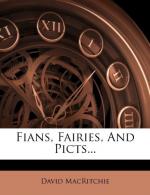[Illustration: PLATE V.
GROUND PLAN OF RUINED BOTH AT BAILE FHLODAIDH,
ON THE NORTH SIDE OF
THE ISLAND OF BENBECULA.
a. “scarcely 18 in. wide.”]
PLATE V.—Ground Plan of Bee-Hive House, Island of Benbecula.
(From Plate XXXII. of Vol. VII. of Proceedings
of the Society of
Antiquaries of Scotland, First Series.)
[Illustration: PLATE VI.
SECTIONAL VIEW AND GROUND PLAN OF MOUND DWELLING,
CALLED BOTH
STACSEAL, SITUATED MIDWAY BETWEEN STORNOWAY AND
CARLOWAY, LEWIS,
HEBRIDES.
“A hole (e), called the Farlos, is left in the apex of the roof for the escape of the smoke, and is closed with a turf or flat stone as requisite.”
Height of Dome, 7 feet.
a, b. Doorways.
c. Fireplace.
d. Row of stones for seats.
e. Centre. (Distance from e to end of cells, 7 feet.)
f, g, h. Cells or bed-places.
f is “2 feet wide and 15 inches high at the inner end; is 5 feet long and 3 feet high at the mouth. The opposite cell (g) is of the same dimensions. The third cell (h) is 4 feet wide at the mouth, 5 feet long, decreasing to 2-1/2 feet wide at the head, where it is 16 inches high."
The above is given by Captain Thomas as an example of such dwellings “having oven-like bed-places around the internal area. This interesting summer house illustrates the most antique form of dormitory; but in the winter houses the floor of the bedroom was raised three or four feet above the ground.” (Compare the side cells in Maes-How, Orkney.)]
PLATE VI.—Chambered Mound (Both Stacseal),
near Stornoway,
Lewis.
(From Plate XXXII. of Vol. VII. of Proceedings
of the Society of
Antiquaries of Scotland, First Series.)
With reference to the farlos, or smoke-hole (otherwise “sky-light"), which, in this instance, is at a height of 7 feet from the floor of the dwelling, Captain Thomas remarks:—“A man, on standing upright, can often put his head out of the hole and look around” (op. cit., vol. iii., p. 130 n.). This suggests the following story, told by Mr. J.F. Campbell (West Highland Tales, vol. ii., pp. 39-40):
“There was a woman in Baile Thangusdail, and she was out seeking a couple of calves; and the night and lateness caught her, and there came rain and tempest, and she was seeking shelter. She went to a knoll with the couple of calves, and she was striking the tether-peg into it. The knoll opened. She heard a gleegashing (gliogadaich) as if a pot-hook were clashing beside a pot. She took wonder, and she stopped striking the tether-peg. A woman put out her head and all above her middle, and she said, ’What business hast thou to be troubling this tulman [mound] in which I make my dwelling?’ ’I am taking care of




